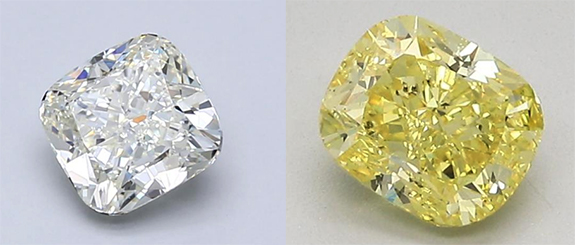Lab-grown Diamonds vs. ‘Natural’ Diamonds
What is the lab-grown diamond difference that can get you a better diamond for less money?
Sure, most people want real diamonds, but lab-grown diamonds and other diamond simulants are quickly becoming much more popular. When it comes down to it, there is nothing wrong with a man-made diamond, a lab diamond, or synthetic diamonds, whatever you want to refer to them as.
You can’t shop for diamonds without quickly seeing offers and entire selections of “lab-grown diamonds.”
At James Allen, for example, that’s one of the first decisions you can make when you click on the “diamonds” tab and begin shopping for an engagement ring.
That’s the case at other retailers, too. Virtually any reputable diamond retailer online (or brick-and-mortar jeweler) clearly labels lab-grown diamonds as separate from “natural” diamonds.
Why is this? And how can you use perceptions, and market demands, to your advantage?
What is a lab-grown diamond?
A lab-grown diamond is simply a diamond which is created in a lab, instead of mined after the earth-created it.
It’s accomplished by creating the conditions that formed diamonds in the earth: enormous pressure and heat, in the presence of carbon.
The resulting gemstones are diamonds. In every sense. They’re not fake. They’re not “substitute.” They’re actual diamonds, just like the ones mined from the earth.
The procedure is complex, of course. The details are. But that’s it, in a nutshell. Amazing, right? People can create diamonds.
Want to know more about how lab-created diamonds are formed in a lab?
And do you want to see the history of a rebel chemist at GE who broke away and made a fortune after his employer gave him a mere $10 savings bond to reward him for his historic achievement of creating diamonds in a lab for the first time?
Then check out my article “What are laboratory grown diamonds?”
Why do jewelers label lab-created diamonds differently than ‘natural’ diamonds?
Lab-created and “natural” (earth-created) diamonds are exactly the same in every physical way. Yet jewelers clearly differentiate the two due to their differences in origin, consumer perception, and market demand.
Lab-grown diamonds differ from earth-grown diamonds in how much people are willing to pay for them. But as individual gemstones, they’re physically, chemically, and optically identical.
How lab-made diamonds are different than ‘natural’ diamonds
Lab-made diamonds, as a group, have less color variation than earth-made diamonds. Lab-made diamonds are engineered to be mostly white/clear because that’s what consumers want.
Here, I’m going to illustrate four facts that you won’t find explored on many diamond blogs. But the bottom line is very important to you, the consumer.
1. Overwhelmingly, consumers prefer colorless diamonds
Traditional diamonds are graded on a color scale with the clearest (least colorful) diamonds being the most valuable.
Now, it’s true that some people love black diamonds. And “fancy” colors. “Fancy” is a gemologist term that designates the color intensity of a diamond which is not intended to be colorless. Fancy blue diamonds are extremely rare, desirable and expensive, for example.
Another prized fancy color is fancy yellow. As opposed to “clear” diamonds with a yellow tint, fancy yellow diamonds are prized for their saturated yellows.
If you have a regular white diamond, which ideally should be colorless, but it has a yellowish tint? Well, that’s bad, of course.
But if a person desires a lemony yellow or sunlight yellow diamond? They’ll pay more for the intensity of that color.

Other fancy colors include pink, red, and green.
But this is the point: By far the largest market demand is for “white,” or colorless diamonds. And it’s not easy to find diamonds that don’t have a slight (or significant) yellow tint.
The more yellowish a white diamond is, the less value it has — all other things being equal.
2. ‘Natural’ diamonds come in many colors, but not all are valuable
Earth-created diamonds were formed 3 billion years ago. Before markets. Before wedding rings. Before anything other than bacteria squirmed on this earth.
So, earth-created “white” diamonds run the gamut of color quality. A few are perfectly colorless. Not many.
Many more are slightly yellow. Or ghastly yellow, to be honest. That’s just the way nature made them.
So, as a class, earth-created diamonds have “poorer” color, according to people’s subjective opinion of what a beautiful diamond should look like.
As individual gemstones, they’re identical to any lab-grown diamond.
But as a class, they’ll have far more yellow.
See what I mean?
Here’s an illustration to spell it out. This stat is not real, it’s just an illustration of reality: 75% of earth-created diamonds might have too much yellow to be highly-prized.
But because lab-grown diamonds are made to meet market demand, they’ll have a lower percentage of yellow diamonds, taken as a class.
3. Lab-grown diamonds are engineered to be colorless
Lab-grown diamonds are made for one fundamental reason: to add value to the lives of consumers, so that the companies creating them can receive value in return. That is: to make a profit by making a superior product.
So, as opposed to earth-created diamonds, which have no thought of market demand, the geniuses who create lab-grown diamonds are all about meeting market demands.
That means they’re all about making diamonds that are as colorless as possible.
And over time, as they learn, and experiment, they succeed better and better.
So this leads us to Fact #4. The happiest fact of all. The payoff for you, the buyer.
4. Due to market bias, lab-grown diamonds are less expensive
People still have a bias against lab-grown diamonds, although they’re identical to earth made “natural” diamonds. So, as a class, their prices are lower.
You feel it. I feel it. Everyone feels it: this nagging question, this doubt: “Are lab-grown diamonds real? Are they fake? Am I getting a substandard product? Even if I accept science and reality, accept that they are in every respect 100% identical to earth-created diamonds, are they maybe unromantic?”
Science says: there’s no difference between lab-grown and earth made diamonds. We can accept that as a fact of physical reality.
But what about the meaning we attach to reality?
Love, romance, gifting, the meaning of a gemstone — these are not scientific questions.
Some people have doubts about lab-grown diamonds because they don’t understand the science.
Some people have doubts about lab-grown diamonds because they emotionally prefer a diamond that was created 3 billion years ago deep within the earth.
That means there is higher market demand (as a group) for earth-created diamonds. And lower demand (as a group) for lab-grown diamonds.
Combine this fact with fact #3 (lab-grown diamonds have better color quality, as a class), then you can see the opportunity: you can often get a better quality lab-grown diamond for less money than an earth-created diamond.
5. You can buy a higher-quality lab-grown diamond for less than lower-quality ‘natural’ diamond
Because lab-grown diamonds are (as a class) of better color quality, and receive (as a class) less market demand, you can often get a better quality lab-grown diamond for less money than an earth-created diamond.
The fact of the matter is that because a lab diamond is created in a controlled environment, its final physical properties can be controlled and altered. Natural diamonds develop how they develop, and there is nothing that people can do about it, which is why real diamonds have so many flaws and variations. However, a lab diamond is going to look much better to begin with and will likely be of a higher quality too. If you look at independent grading reports, you’ll see that a lab diamond can be just as good as natural diamonds.
You can explore the bargains easily using the user-friendly search tools at James Allen, Blue Nile, or other online diamond retailers.
How to get a deal on a lab-grown diamond
Not all lab-grown diamonds are less expensive than earth-created diamonds of similar quality. To find the deals, you need to comparison shop carefully.
Here, I’ll walk you through the comparison shopping procedure at James Allen.
- Open the James Allen diamond search tool in two different browser tabs.
- In the first window, leave it set as “Earth-Created Diamonds.”
- In the second window, select “Lab-Created Diamonds.”
- Adjust the search filters / sliders in each window to exactly the same parameters.
- Look for bargains in the “Lab-Created Diamonds” window.
- You’ll likely find some lab-grown diamonds, identical in every way to earth made diamonds, for less money.
That’s not a guarantee. And it won’t last forever because the prejudice against lab-grown diamonds is fading quickly every day.
What is a lab-grown diamond worth?
Unlike earth-created diamonds, whose prices change slowly, lab-grown diamond pricing fluctuates wildly from year to year.
For years, lab-grown diamonds were generally less expensive than earth-created diamonds. This assumed each diamond was essentially identical in color, weight, clarity, shape, and cut quality.
As a rule, lab-grown diamonds were around 10 to 40 percent less expensive than earth-grown diamonds. For example, if an earth-created diamond was $1,000, then the lab-grown diamond would cost between $600 to $900, generally speaking. Therefore, if you are looking for a lab diamond engagement ring, this might be a good idea because you will end up saving a lot of money. Laboratory-grown diamonds may be much more affordable than real diamonds, but no worse.
But in recent years, some lab-grown diamonds have been valued the same, or even slightly more than equivalent earth-grown diamonds.
What’s going on?
Why are lab-grown diamonds sometimes more expensive than ‘natural’ diamonds?
Like anything, diamond prices are a product of supply and demand. When there are fewer lab-grown diamonds on the market relative to earth-grown diamonds, their values go up.
That’s the simple answer. The full answer is more complex. It’s also a bit like a conspiracy theory crashing into a sci-fi movie.
Only, this one isn’t a conspiracy theory. It’s more like conspiracy truth! Only, it’s not really a conspiracy. It’s not a secret. It’s just marketing genius paired to a control of supply.
How diamond pricing works
A few large diamond mining conglomerates control the supply (and therefore the price) of diamonds.
Diamond suppliers patiently dole out diamonds to the market according to demand to keep prices high.
They also created the cultural expectation of diamonds as engagement ring gemstones with massive advertising and PR campaigns like the infamous “A Diamond is Forever” campaign by DeBeers, the largest diamond company in the world.
Not that there’s anything wrong with that. It is what it is, at this point in time. And if it makes you feel any better (and it should), remember that our most precious holidays were established similarly by religious or civic or tribal communications and proclamations and ceremonies.
It’s the way culture works in the modern world. It’s the same with Mother’s Day. Or Father’s Day. Or the Pledge of Allegiance.
Earth-created diamonds are expensive mostly because the diamond companies want them to be expensive. Yes, diamonds are rare. It’s also expensive to mine, cut, transport and market them. Diamonds will never be cheap.
But the main dynamic determining the price of earth-created diamonds is supply and demand. And that supply is artificially controlled by the mining industry.
How lab-grown diamond pricing works
Lab-grown diamonds are man-made and can be created on demand. Their pricing is also a function of supply but also, more-so than earth-created diamonds, demand. Lab-grown diamond prices are also influenced by the supply of earth-created diamonds.
Lab-grown diamonds appeal to consumers based on appearance, sometimes lower pricing and — importantly — perceived ethical superiority. Lab-grown diamonds are not connected at all to conflicts, slavery or environmental damage.
But lab-grown diamonds have to fit in with current prices of earth-grown diamonds. They walk a fine line.
The companies producing lab-grown diamonds don’t want to flood the market and lower prices dramatically for the very product they are creating.
So, for now, diamond growers ride on their product’s pricing advantage which is due precisely to people’s feelings. That is to say, some people’s feelings that earth-created diamonds are superior.
I think what we’ll see in coming decades is a gradual lowering of diamond prices, based on more and more price undercutting from diamond manufacturers.
Why do some people prefer lab-grown diamonds?
Aside from price, some people prefer lab-grown diamonds because they are environment-friendly and they lack the ethical concerns that are a part of the earth-created diamond industry’s history.
Lab-grown diamonds are perceived to be a more ethical choice.
The truth is that reputable diamond companies today deal in only conflict-free diamonds. In other words, they do not buy from countries or mines that use slave labor or — quite bluntly — murder people over diamonds. You Sadly, this hasn’t always been the case. Nobody wants to buy a blood diamond that was harvested through child or slave labor. Naturally-mined diamonds often aren’t conflict free.
But you may not quite believe that the diamond industry is 100% confident about their conflict-free certification. Or, you may wish to vote with your wallet and not support an industry that once tolerated such atrocities.
Either way, you know that diamonds created in a lab have nothing to do with slave labor, guns or violence of any kind.
Lab-grown diamonds are most likely better for the environment.
Mining involves tearing up the earth and extracting elements from deep within it. With all mining comes many different environmental impacts.
At the same time, any industrial process has environmental costs of some kind. Even making diamonds in a lab. But overall, it’s hard to argue that the resources expended to make lab-created diamonds do not come close to the worldwide environmental costs of diamond mining.
An argument can be made that a lab-grown diamond is another way to celebrate human ingenuity.
Sure, it was made by a corporation. But so is a Tesla. So is an iPhone. These are miracles of human ingenuity, and so is a lab-created diamond.
Why do some people prefer earth-created diamonds?
There are two arguments for choosing “natural diamonds” over lab-created diamonds. One is the fact that earth-created diamonds were made by nature billions of years ago. The other is the perception that earth-created diamonds will always “the real thing” and/or more valuable.
Many consumers just feel more comfortable with earth-created diamonds.
Even though they may have heard, and intellectually believe, that lab-created diamonds are identical, they don’t feel the same about them. The importance of feelings such as these cannot be overstated when it comes to relationships and romance. After all, that’s the whole point of a diamond in the first place: It’s a symbol of love.
They feel a profound sense of meaning and connection to a stone that has been around for 3 billion years.
That is deeply profound. True, a philosopher can point out that every piece of matter has been around for billions of years. But it feels different, to most people, to know that this particular stone has been around for 3 billion years. More less in its current form. (Although, it was not cut, or polished, for those three billion years, it was there.)
Conclusion
I think earth-created diamonds will always a special place in most people’s hearts that is difficult to replace. It’s hard to beat the transcendence of 3 billions years. And the symbol that has for eternal love. What needs to be considered however is that laboratory-grown diamonds are not the same as fake diamonds. These are real diamonds, but they just don’t come from the earth below out feet.
At the same time, lab-grown diamonds are exactly the same stones. No physical difference at all. They are miracles of both nature (in the way they are created) and human ingenuity (in the way we have recreated a natural process that used to take billions of years).
Ultimately, the choice will be up to you. If you are convinced in the physical equality of lab-grown diamonds to “natural diamonds” and you can find a higher-quality lab-grown gem for less; it’s a beautiful thing.
Recommended Jewelers
James Allen
James Allen is the most competitive diamond vendor with more than 150,000 loose diamonds in inventory. They have been a leader in selling diamonds online and pioneered 3D imaging so you can see the exact diamond you're buying in exquisite detail. You'll find it hard to beat James Allen in terms of price or selection. Read our James Allen review. |
Whiteflash
Whiteflash is the home of "A Cut Above" diamonds which are among the best quality round- and princess-cut diamonds in the world. With superior diamond photographs and videos, Whiteflash's diamonds seem to come to life -- even online. Read our Whiteflash review. Shop Whiteflash » |
Brilliant Earth
Brilliant Earth is the global leader in ethically-sourced jewelry. Brilliant Earth goes above and beyond existing standards to offer “Beyond Conflict Free Diamonds” that they select for their ethical and environmentally-responsible origins. With over 120,000 diamonds in inventory, you can be sure to find your perfect diamond and feel good knowing it was responsibly-sourced. Read our Brilliant Earth review. Shop Brilliant Earth » |
Blue Nile
Blue Nile is the world's largest online jeweler. Their reputation for quality and customer service is unparalleled in the industry. Blue Nile offers free shipping, a 30-day return policy and satisfaction guarantee. Read our Blue Nile review. Shop Blue Nile » |